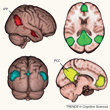Tuesday, 6 January 2015
Literary Activity and the Default Mode Network

In every human culture, much of life revolves around the stories that we tell—about the world around us, about other people, and about ourselves. When you come right down to it, just like traditional oral storytelling, that is all that modern literature and film do today. There must be something in the brain that resonates especially strongly with the narrative process.
That something might well resemble what neuroscientists call the the brain’s default mode network: the particular set of brain structures whose activity increases by default, when someone is doing absolutely nothing.
But as these structures have been studied more and more using functional brain imaging techniques, and as more meta-analyses have been performed on existing studies (such as the meta-analysis published by Richard J.S. Wise and Rodrigo M. Braga in December 2011), researchers have increasingly come to recognize that this default mode network is also activated in various situations in which we are not really so idle as all that. In fact, scientists are beginning to understand that this network is associated with what is commonly called introspection: thinking about ourselves, about other people, about what we have done, and about what we are going to do.
In their study, Wise and Braga found that the default mode network and other brain structures become active when subjects are presented with spoken or written versions of a story. These other structures include not only the sensory (auditory and visual) areas that are directly involved in hearing or reading a story and that converge on the brain’s language network (“bottom-up” brain activity), but also the brain networks that we use to make inferences, to remember, to imagine, and to be creative—“top-down” brain activities that are just as essential for understanding a story.
Wise and Braga find that these other brain structures interact functionally with the default mode network to perform a task that is highly complex but that we carry out effortlessly all the time: understanding stories when they are told to us.
![]() Default mode network: the seat of literary creativity?
Default mode network: the seat of literary creativity?
![]() Default Mode Network: The Seat Of Literary Creativity?
Default Mode Network: The Seat Of Literary Creativity?
From Thought to Language | Comments Closed








